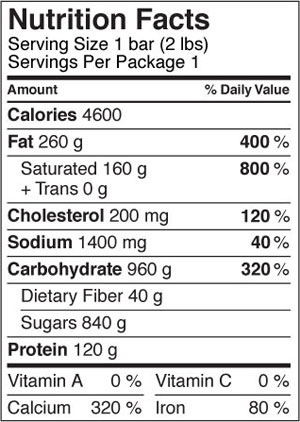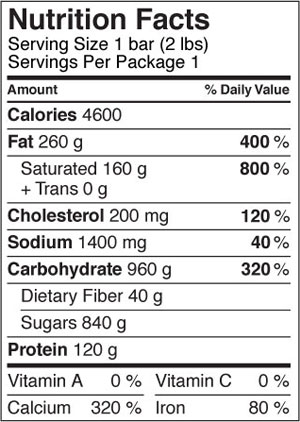
LSAT Logical Reasoning Tips: June 09, LR2, #14 – or – Crappy Calorie Question
It is time, my friends. Time, that is, for another Logical Reasoning question. As you may be aware, I have been breaking down a series of Logical Reasoning questions from the June LSAT. Hopefully these posts have been helpful in showing you the way that you need to approach different types of LR questions. (The subject matter is slightly altered so as not to run afoul of any licensing rules with the fine folks over at LSAC).
Well, now it is time for a real bitch. In my humble opinion, this is one of the hardest questions from the June test.
June 2009, LR2, #14
First of all, it is a hard question type. Second, it is a difficult stimulus to diagram and visualize. Third, the answer choices talk about a food company named Lester’s, which might be the most unfortunate name for a food company ever (you know, because it rhymes with molester and all, and who wants to buy milk from someone with a name like that).
But let’s put all of that aside and give it a shot. I am going to do this one with you in real time to illustrate how you can get through a tough question like this.
First, read the prompt and figure out what type of question you are dealing with.
- Which one of the following situations violates the food labeling regulation?
Now this is not a very common type of question on the LSAT. Also, it does not contain the key words that normally give it away. But this is a Must Be False (MBF) question. Essentially, they are going to outline some sort of regulation in the stimulus regarding food labeling (exciting, I know). And then we need to identify an answer choice that violates that regulation. Some terrible food producer has chosen to violate the rules. Or, in other words, one of the answer choices cannot be true or must be false according to the regulation.
Must Be False questions are rare on the LSAT; you will only get 1 or 2 on your entire exam. But they tend to be tough because students have issues thinking in terms of falsity. We are used to figuring out what is proven true, but false is a whole new issue. Sometimes the prompt will simply ask for an answer that must be false or cannot be true, but they will also introduce these questions by seeking an answer choice that contradicts the stimulus or violates the stimulus or is inconsistent with the stimulus.
Here is one trick that you can use on a MBF question. First, anticipate what must be true. Generally, this is an easier first step for students. Then just use that conclusion to anticipate what would have to be false. Let me give you a simple example.
- All trapeze artists have good life insurance. Some people with bad balance foolishly become trapeze artists.
If all of the statements above are true, then which one of the following CANNOT be true?
This would be a Must Be False question. There are two statements in the stimulus and here is how you should approach this situation. Just jumping in and trying to think of something false is very difficult, but first let’s figure out what must be true.
- 1. Trapeze Artist → Good Life Insurance
2. Bad Balance some Trapeze Artist
This is actually a very common deduction on the LSAT that involves combining a conditional statement with a some statement. If all trapeze artists have good life insurance and some trapeze artists have bad balance (bad call, kinda like Sarah Palin going into family planning), then it must be true that some people with bad balance have good life insurance.
Now that you realize what must be true, it is easier to think about an answer that must be false. Since you now know that some people with bad balance have good life insurance, it would be false to say that no one with bad balance has good life insurance or to say that no one with good life insurance has bad balance. And that is what you anticipate. The right answer would look something like this.
- (B) No one with good life insurance has bad balance.
Now that we have covered the general approach (and fulfilled my deep desire to discuss circus performers), back to our question. Here is the stimulus.
- Food labeling regulation: Food of a type that does not ordinarily contain a high number of calories cannot be labeled “low calorie” unless most people mistakenly believe the food ordinarily contains a high number of calories. If most people mistakenly believe that a food contains a high number of calories, the food may be labeled “low calorie” if the label also states that the food ordinarily contains a low number of calories.
So this question touches on an issue that hits close to home. I just had an argument with a friend about what I consider to be the insulting idea that companies that sell me bottled water find it necessary to include nutrition information on the label. Really? Do I really need to know that my Aquafina has 0 grams of fat? Was I wondering how many calories are in my bottle of Arrowhead? And how about what percentage of my recommended daily value that accounts for? Ridiculous.
Anyway, here is the regulation, and it is a bit wordy. The first sentence states that a low calorie food cannot be labeled “low calorie” unless most people think that is has a lot of calories. If most people do not think a food has a lot of calories, then it should not be labeled “low calorie.” Or, an easier way to put it, if most people know it is low calorie, then don’t put it on the label. You hear that, Dasani?
- Most people know it is low calorie → Don’t label “low calorie”
The second sentence states that if most people do mistakenly think a food has calories, then you can label it “low calorie” as long as the label also explains that the food normally does not have calories. Essentially, you can set people straight but you can’t act like you are special. So here would be that part of the regulation.
- Most people mistakenly think calories → Can label “low calorie” but not special
Now we are ready to go. The first big obstacle is to simplify the regulations, which we have now done. Next step is anticipation.
There is no way to combine the regulations since they are dealing with different types of products. But still take some time to think about what you are looking for in an answer. First, both of these regulations have to do with foods that are low in calories, so if any answer choice talks about other food products or does not say that the food is low in calories, then that will be an easy way to knock out answers.
Of the remaining few, if people know it does not have calories, then don’t tell them what they already know. So if an answer said that everyone knows bottled water is low in calories and yet every company labels it “low calorie,” that would violate the regulation.
And if most people mistakenly think that a food has calories, then you can label it “low calorie” as long as you explain that it is not special. So if an answer said pita bread is mistakenly believed to have a high number of calories and it is labeled “low calorie” but does not explain that the food normally does not have calories, this would also violate the regulations.
One of those two things will always be the answer. I guarantee it (cue bad Men’s Wearhouse guy). The key is just to do the legwork.
So here are the answers. I will give them to you one-by-one and try to figure out whether the answer violates the regulations before reading my explanation.
- (A) Although most people know that bran flakes do not normally contain a high number of calories, Lester’s Bran Flakes are not labeled “low calorie.”
See, I told you it was coming. Lester (the molester) Food Producers. This answer is actually right in keeping with the regulations. Most people know bran flakes (yummy, just like eating chalk for breakfast) don’t have calories and they don’t label it. So that is the proper action according to the regulations. No go on (A). Next…
- (B) Although most people are aware that lasagna ordinarily contains a high number of calories, Lester’s lasagna, which contains a low number of calories, is not labeled “low calorie.”
Did you go for that? I am guessing that this was a popular answer choice. But stick to your guns, that is not what we said the answer would sound like. If you think about it, this situation is not even covered by the regulations. Here, most people are correct that lasagna has a lot of calories (meat and cheese, mmmm). But we only know the rule if people mistakenly think that a food normally has a high number of calories.
And, even if you took this to mean that people are mistaken about Lester’s lasagna, there is another problem. If that were the case, then Lester would totally be allowed to label his lasagna as “low calorie,” but he does not have to do so. Maybe he isn’t selling the health benefits of his lasagna and just wants people to buy for taste.
So (B) is tempting but stay away. And then…
- (C) Although most garlic bread contains a high number of calories, Lester’s garlic bread is labeled “low calorie.”
Well, now, wait just a second, Lester. That is messed up. So garlic bread actually does have a bunch of calories and Lester just lies and says that is does not. That might be wrong, and that might be unethical, but that actually does not violate our regulations.
Here, we know that most garlic bread does contain a high number of calories. But does Lester’s? We actually don’t know, so there are lots of problems here. Get it out of here. Still looking for a winner…
- (D) Although most people are aware that applesauce does not normally contain a high number of calories, Lester’s applesauce is labeled “low calorie.”
What do you think? I am hoping you think we just found our answer. Because we did.
Remember, we simplified the first regulation to say that if most people know it does not have calories, then don’t label it. Here, most people know damn Lester and his damn applesauce doesn’t have calories (because it is mushed up apples, after all) and yet Lester still labels it “low calorie.” That is not allowed and that makes (D) our answer.
Note that this answer becomes much more apparent when you take the time to simplify the stimulus and anticipate the answer. Spend that extra minute up top so that you save a couple minutes when you would normally be debating answer choices. Just for kicks, here is the last one…
- (E) Although most people mistakenly believe that salsa ordinarily contains a high number of calories, Lester’s Zesty Salsa says “This product, like all salsas, is low in calories.”
Yikes, now they put the words Lester and Zesty next to one another. Creepy. This answer would be great if they were asking us for something that follows the regulations, but that is not what we are looking for. Here, most people mistakenly think that salsa has a high number of calories, so Lester tells them his salsa is low in calories and he also appropriately tells consumers that his salsa is not special.
So we confidently go with (D) on this one.
That is another question in the books. I hope you are enjoying your summer of LSAT studying. I know that sweating in the heat and having nightmares about parallel questions may not compare to sunny beaches, but it will all pay off in the end.
I will be back with more installments. But now I gotta run to meet up with my buddy Lester.
P.S. What would you rate the difficulty for that question: 1 to 10? I think I would give it a 7.5.




